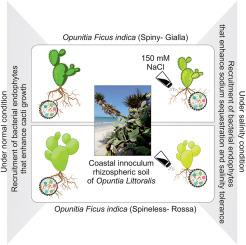Differential recruitment of root bacterial community by inoculated inland spiny and spinless cactus in response to salinity stress
IF 4.3
3区 材料科学
Q1 ENGINEERING, ELECTRICAL & ELECTRONIC
引用次数: 0
Abstract
In the field of innovative challenges, it is essential to incorporate microorganisms into agricultural practices that promote and improve plant growth and health, particularly under conditions of salinity stress. This work elucidated the response of two Opuntia ficus-indica cultivars (spiny, Gialla and spineless, Rossa) inoculated inland with a coastal cactus rhizospheric soil (Opuntia littoralis) under NaCl treatment. The two cultivars reacted differently to salinity stress. The cladodes and roots of the Rossa cultivar were sensitive to salinity and accumulated both Na+ and Cl−. In contrast, the Gialla cultivar showed Na + exclusion from the cladodes and root growth was unaffected by salinity. The diversity, richness, and correlation networks of root compartments bacterial communities were mainly determined while the cactus cultivar was subjected to salinity stress. Different subsets of key soil bacteria taxa were selected by the root systems of each cultivar after exposure to salinity. Our results highlight the importance of the rhizosphere of endemic coastal plants in improving plant resistance to salinity stress, particularly in the spiny cultivar compared to the spineless cultivar. The microbiome networks provide solid evidence that each cultivar adapts its bacterial community composition and interactions in response to salinity.

接种内陆刺仙人掌和无刺仙人掌的根部细菌群落对盐度胁迫的响应差异
在创新挑战领域,将微生物纳入农业实践,促进和改善植物生长和健康至关重要,尤其是在盐度胁迫条件下。这项研究阐明了在内陆接种沿海仙人掌根瘤土壤(Opuntia littoralis)的两个茵芋栽培品种(有刺的 Gialla 和无刺的 Rossa)在氯化钠处理下的反应。这两种栽培品种对盐度胁迫的反应不同。Rossa 栽培品种的根茎和根部对盐度很敏感,会积累 Na+ 和 Cl-。与此相反,Gialla 栽培品种的根茎表现出对 Na+ 的排斥,根系生长不受盐度影响。仙人掌栽培品种受盐度胁迫时,根区细菌群落的多样性、丰富度和相关网络主要取决于盐度胁迫。每个栽培品种的根系在受到盐分胁迫后选择了不同的关键土壤细菌类群子集。我们的研究结果凸显了沿海特有植物根瘤层在提高植物抗盐碱胁迫能力方面的重要性,特别是与无刺栽培品种相比,有刺栽培品种的根瘤层在提高植物抗盐碱胁迫能力方面的重要性。微生物组网络提供了确凿的证据,证明每个栽培品种都会调整其细菌群落组成和相互作用以应对盐度。
本文章由计算机程序翻译,如有差异,请以英文原文为准。
求助全文
约1分钟内获得全文
求助全文

 求助内容:
求助内容: 应助结果提醒方式:
应助结果提醒方式:


